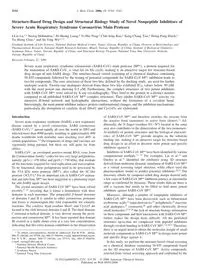
2006 Structure-Based Drug Design and Structural Biology Study of Novel Nonpeptide Inhibitors of Severe Acute Respiratory PDF
Preview 2006 Structure-Based Drug Design and Structural Biology Study of Novel Nonpeptide Inhibitors of Severe Acute Respiratory
Structure-Based Drug Design and Structural Biology Study of Novel Nonpeptide Inhibitors of Severe Acute Respiratory Syndrome Coronavirus Main Protease I-Lin Lu,†,‡ Neeraj Mahindroo,‡ Po-Huang Liang,§ Yi-Hui Peng,| Chih-Jung Kuo,§ Keng-Chang Tsai,‡ Hsing-Pang Hsieh,‡ Yu-Sheng Chao,‡ and Su-Ying Wu*,†,‡ Graduate Institute of Life Sciences, National Defense Medical Center, Taipei, Taiwan, Republic of China, DiVision of Biotechnology and Pharmaceutical Research, National Health Research Institutes, Miaoli, Taiwan, Republic of China, Institute of Biological Chemistry, Academia Sinica, Taipei, Taiwan, Republic of China, and Structural Biology Program, National Tsing Hua UniVersity, Hsinchu, Taiwan, Republic of China ReceiVed February 22, 2006 Severe acute respiratory syndrome coronavirus (SARS-CoV) main protease (Mpro), a protein required for the maturation of SARS-CoV, is vital for its life cycle, making it an attractive target for structure-based drug design of anti-SARS drugs. The structure-based virtual screening of a chemical database containing 58 855 compounds followed by the testing of potential compounds for SARS-CoV Mpro inhibition leads to two hit compounds. The core structures of these two hits, defined by the docking study, are used for further analogue search. Twenty-one analogues derived from these two hits exhibited IC50 values below 50 µM, with the most potent one showing 0.3 µM. Furthermore, the complex structures of two potent inhibitors with SARS-CoV Mpro were solved by X-ray crystallography. They bind to the protein in a distinct manner compared to all published SARS-CoV Mpro complex structures. They inhibit SARS-CoV Mpro activity via intensive H-bond network and hydrophobic interactions, without the formation of a covalent bond. Interestingly, the most potent inhibitor induces protein conformational changes, and the inhibition mechanisms, particularly the disruption of catalytic dyad (His41 and Cys145), are elaborated. Introduction Severe acute respiratory syndrome (SARS), a new respiratory disease caused by a novel coronavirus, SARS coronavirus (SARS-CoV),1,2 spread rapidly all over the world in 2003 and infected more than 8000 people, resulting in approximately 800 deaths worldwide with mortality rates reaching over 40% in certain populations.3,4 Developments of drugs and vaccines are vigorously being pursued, but these are still quite far from clinics. SARS-CoV, an enveloped positive-strand RNA virus from the Coronaviridae family,5 codes for two very large polyproteins, namely, pp1a (∼450 kDa) and pp1b (∼750 kDa), that mediate all the functions required for viral replication and transcription. To be functional, these polyproteins need to be processed by the 33.8 kDa main protease (Mpro), also called the 3C-like protease (3CLpro).6 For its important role in SARS-CoV matura- tion and infection, Mpro has been suggested as a promising target for anti-SARS agent design. The crystal structures of SARS-CoV Mpro have been solved recently,7-11 revealing that it forms a homodimer with three domains in each monomer. The antiparallel �-barrel structure of domains I and II is similar to other coronavirus proteases and forms a chymotrypsin-like fold responsible for catalytic reactions. The catalytic dyad residues His41 and Cys145 are located at the cleft between domains I and II. The third domain, C-terminal R-helical domain, is very diverse among the picor- navirus and coronavirus Mpro. It has been reported that domain III existed as a stable dimer even at a very low concentration, indicating that this extra domain contributes to the dimerization of SARS-CoV Mpro and therefore switches the enzyme from the inactive form (monomer) to active form (dimer).12 Ad- ditionally, the N finger (residues N1∼N7) located in the same area also contributes to the dimerization of the two monomers. Availability of protein structures and the biological character- istics of SARS-CoV Mpro provide insights on the substrate binding site, making it an attractive target for structure-based drug design in an effort to discover more potent and specific inhibitors against it. Inhibitors of SARS-CoV Mpro have been identified by various computational methods.13-19 For examples, Liu et al.14 and Dooley et al.15 identified the inhibitors using 3D structure derived from molecular dynamic simulation of SARS-CoV Mpro as a virtual screening target structure, while others used the pharmacophore model to predict potential inhibitors.20,21 The discovery efforts by computer-aided drug design showed only a few cases of SARS-CoV Mpro inhibition potency at micromolar range as confirmed by bioassay. These results indicate there is still a vacuum that needs to be filled to find more potent inhibitors against SARS-CoV Mpro. Moreover, although a number of nonpeptide inhibitors of SARS-CoV Mpro have been discovered, such as bifunctional arylboronic acids,22 isatin derivatives,23 polyphenols,24 etacrynic acid analogues,25 cinanserin,26 and other chemically diverse small molecules,15,27,28 the lack of structure biology information on these compounds and their interactions with SARS-CoV Mpro further makes the design more difficult. All the published structures up-to-date are complexed with peptidyl inhibitors through covalent bonding to SARS-CoV Mpro.7,8,10,11 Therefore, there is an urgent need to obtain the molecular insight of small molecule compounds to SARS-CoV Mpro to design more potent and specific drugs against it. In this study, we perform the structure-based virtual screening on a chemical database containing 58 855 compounds based on the 3D structure of SARS-CoV Mpro. Active compounds, selected from virtual screening approach and confirmed by the * To whom correspondence should be addressed. For H.-P.H.: phone, 886-37-246166, ext 35708; fax, 886-37-586456; e-mail,
